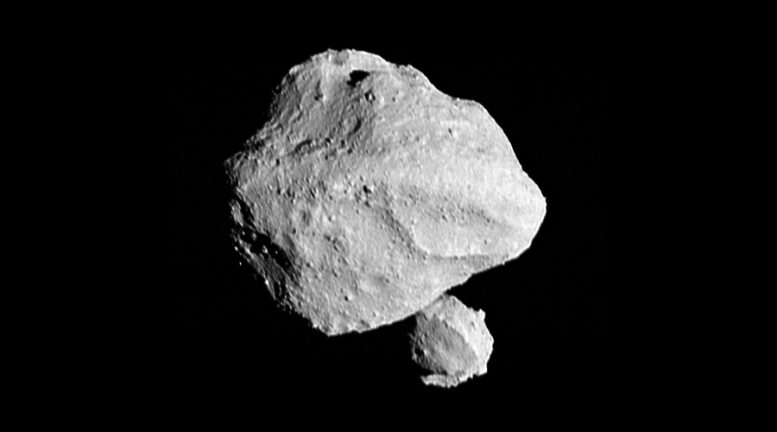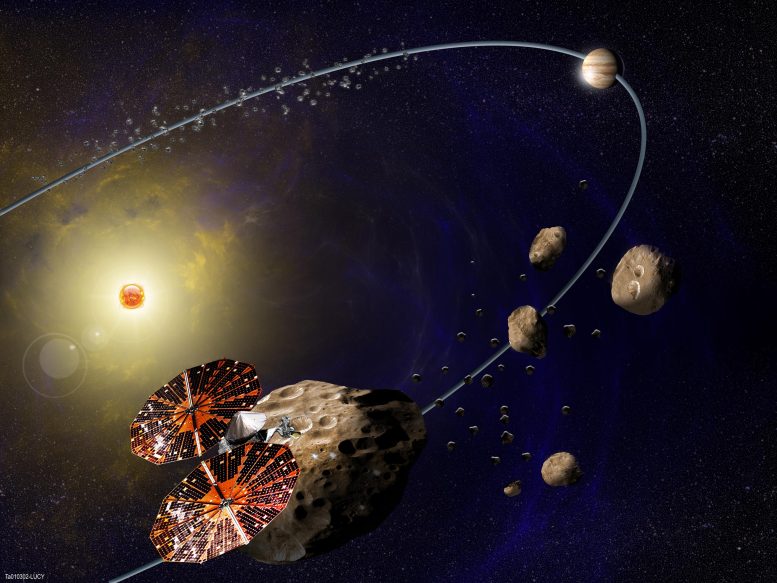
NASA’s Lucy spacecraft has captured striking images of asteroid Donaldjohanson, revealing it to be a contact binary with an unusual “ice cream cone” shape.
This unexpected geological complexity offers insights into the early solar system. Although not a primary target, this encounter served as a full-scale test for Lucy’s instruments before it ventures toward its main objectives, the Trojan asteroids near Jupiter.
Asteroid Encounter Unveils 150-Million-Year-Old Fragment
During its second asteroid flyby, NASA’s Lucy spacecraft captured a close-up view of an unusually shaped asteroid fragment believed to have formed around 150 million years ago. On April 20, 2025, Lucy passed within approximately 600 miles (960 kilometers) of the asteroid known as Donaldjohanson, and has begun transmitting images from the encounter.
Prior observations had shown the asteroid’s brightness changing significantly over a 10-day period, hinting at an irregular shape. These suspicions were confirmed when Lucy’s first images revealed what appears to be an elongated contact binary, an object formed when two smaller bodies merge. What surprised scientists was the narrow, twisted neck linking the two lobes, which resembles a pair of stacked ice cream cones.

Clues to Planet Formation Hidden in Geology
“Asteroid Donaldjohanson has strikingly complicated geology,” says Hal Levison, principal investigator for Lucy at Southwest Research Institute, Boulder, Colorado. “As we study the complex structures in detail, they will reveal important information about the building blocks and collisional processes that formed the planets in our Solar System.”
Initial analysis of the images from Lucy’s L’LORRI camera suggests the asteroid is larger than expected, measuring about 5 miles (8 kilometers) long and 2 miles (3.5 kilometers) wide at its broadest point. Because the asteroid is too large to fit entirely within the camera’s field of view, only part of it is visible in this first batch of high-resolution images. It will take about a week to receive the rest of the data, which will help scientists create a more complete model of the asteroid’s overall shape.

Dress Rehearsal for Bigger Discoveries Ahead
Like Lucy’s first asteroid flyby target, Dinkinesh, Donaldjohanson is not a primary science target of the Lucy mission. As planned, the Dinkinesh flyby was a system’s test for the mission, while this encounter was a full dress rehearsal, in which the team conducted a series of dense observations to maximize data collection. Data collected by Lucy’s other scientific instruments, the L’Ralph color imager and infrared spectrometer and the L’TES thermal infrared spectrometer, will be retrieved and analyzed over the next few weeks.

Credit: Southwest Research Institute
Onward to Jupiter’s Trojan Asteroids
The Lucy spacecraft will spend most of the remainder of 2025 travelling through the main asteroid belt. Lucy will encounter the mission’s first main target, the Jupiter Trojan asteroid Eurybates, in August 2027.
“These early images of Donaldjohanson are again showing the tremendous capabilities of the Lucy spacecraft as an engine of discovery,” said Tom Statler, program scientist for the Lucy mission at NASA Headquarters in Washington. “The potential to really open a new window into the history of our solar system when Lucy gets to the Trojan asteroids is immense.”

NASA’s Lucy mission is a groundbreaking journey to explore the Trojan asteroids—ancient remnants from the early solar system that orbit the Sun near Jupiter. Managed by NASA’s Goddard Space Flight Center in Greenbelt, Maryland, the mission involves extensive collaboration across multiple institutions.
Goddard provides overall mission management, systems engineering, safety, and mission assurance, and also developed the L’Ralph instrument, which captures visible and infrared data. The mission’s principal investigator, Hal Levison, is based at the Southwest Research Institute (SwRI) in Boulder, Colorado. SwRI, headquartered in San Antonio, leads science planning, the science team, and data processing.
Lockheed Martin Space in Littleton, Colorado, built the Lucy spacecraft, designed its complex orbital trajectory, and handles flight operations. KinetX Aerospace and Goddard jointly manage the spacecraft’s navigation.
Lucy is equipped with advanced instruments, including:
- L’LORRI (Lucy Long Range Reconnaissance Imager), built by Johns Hopkins Applied Physics Laboratory, for detailed imaging.
- L’TES (Lucy Thermal Emission Spectrometer), built by Arizona State University, for thermal measurements.
Lucy is the thirteenth mission in NASA’s Discovery Program, which is overseen by NASA’s Marshall Space Flight Center in Huntsville, Alabama. Through this mission, scientists aim to gain new insights into the early history of the solar system.
Never miss a breakthrough: Join the SciTechDaily newsletter.
6 Comments
Sorry… not seeing ice cream cones. More like two potatoes gettin’ nasty.
They mention the place where the two bodies are connected. The regolith there makes a smooth surface and it’s shaped radially over the neck as two cones one inside another. The interesting thing is how such formation occurred.
Appreciate the comment, but… still not seeing ‘cones.
Please see here: https://drive.google.com/file/d/1u0AvfC5QYbjMfAqk7Ebf5bina-FKoWAC/view?usp=sharing
It looks like all the other asteroid closeups so far, like an unshelled peanut.
I’ve never seen an ice cream cone like that.